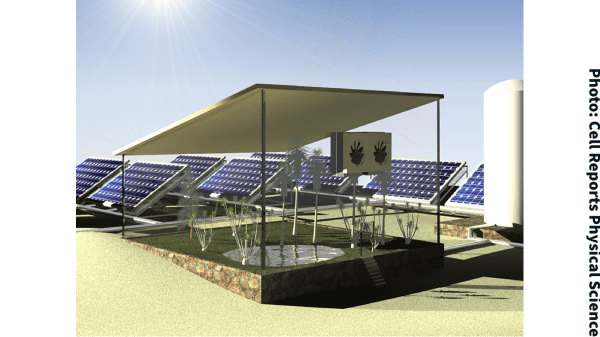Once I visited the Hoh Rainforest in Washington state. It is one of the few temperate rainforests in the world.
Its beauty was unique but eerie. The scene left me with a sense of an intense Darwinian struggle, not for water, but for space. I saw, for example, a tree growing right on top of the dead log of another tree. It had sent its roots around the log into the earth. Air ferns grew hanging from trees without any need for moisture except what they took in from the atmosphere.

A news item in Fast Company by Elissaveta M. Brandon put me in mind of this visit, although it was set in a climate that was as far apart from the Hoh Rainforest as you could imagine: the desert of Saudi Arabia.
A research team led by Renyuan Li of Saudi Arabia’s King Abdullah University of Science and Technology, grew spinach plants out of water they extracted from the atmosphere.
The scientists set up a rig using a solar panel to extract 2 liters of water from the atmosphere to grow healthy seven-inch spinach plants, with a survival rate of 95 percent.
The tools were “a small-scale photovoltaic panel, a composite material made of hydrogel (a high-tech version of the hydrogel used in bandages to re-hydrate wounds), calcium chloride (the kind of salt we use to de-ice roads), plus a metal container that acts as a condensation chamber,” writes Brandon.
The photovoltaic panel converted 10-20 percent of solar energy into electricity. The panel was coated with the hydrogel on the bottom. The calcium chloride, which can absorb more than its weight in water, extracted moisture from the atmosphere. The hydrogel locks the moisture in so that it doesn’t evaporate.
It turns out that relative atmospheric humidity in this area is 40 percent, rising to 80 percent at night. So there’s enough moisture to make use of.
Spinach was chosen because it requires relatively little moisture to grow.
Of course the scale of this experiment is infinitesimal, but the technology does show promise. One can think of many possible applications in places like California, which is running short of water but which certainly has more atmospheric moisture than Saudi Arabia.
An initial impression of this technology suggests that, even if expanded to commercial levels, in most instances it would provide a supplementary rather than a primary source of moisture. But I can think of many contexts where that supplement could be extremely valuable.



